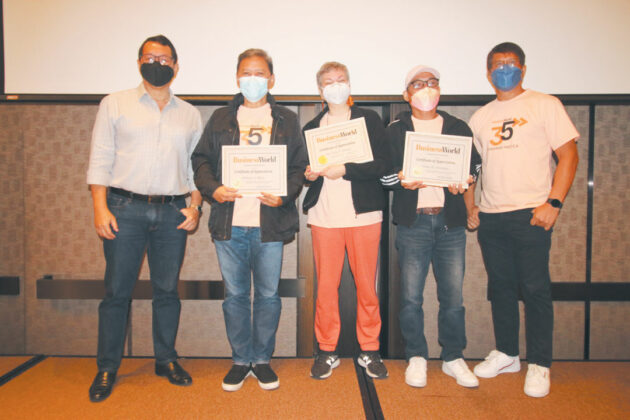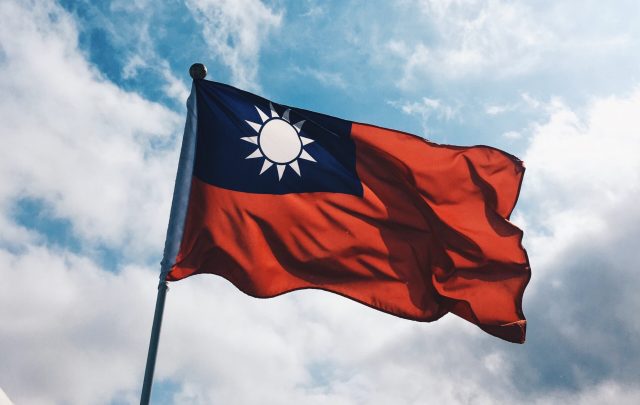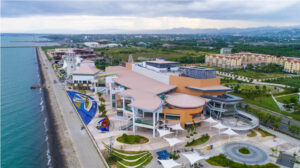Stories from BusinessWorld’s most loyal employees

In standing tall for 35 years now and surpassing various challenges, including global crises, the secret to BusinessWorld’s resilience is its employees, most especially the ones who have been with the company through thick and thin, and have greatly contributed to BusinessWorld’s continued success as the country’s most trusted business newspaper and multimedia content provider today.
As BusinessWorld marks its 35th anniversary, we put the spotlight on some of its most loyal employees who have been serving the publication for 25 to 34 years now. They share with us a glimpse of their own journey in the company — how they started, the roles they have played, memories with BusinessWorld Founder Raul L. Locsin, unforgettable experiences and lessons learned, their reasons for choosing to stay, and wishes for the company they have come to love.
Marlon A. Serrano
Officer-in-Charge, General Services Department
I started working at BusinessWorld in 1988. I joined the company because of its good management, especially under Mr. Locsin. I began as a janitor then a messenger through the years. Mr. Locsin was like a father to me. He was very easy to approach. Overall, working with all the people here is easy. For me, BusinessWorld is my second home. I wish it will be forever.
Hilario T. Matundan
Production Coordinator
My Sunday to Thursday work routine with BusinessWorld has been going on for almost 32 years now. Way back in 1990, I was still single. I was just a small-town boy from Batangas excited to work in the city. Back then, I was looking for a company that is committed to the well-being and professional development of its employees. So, I thought that joining a startup company (BusinessWorld) would be best to have career growth as the company and I could develop further together. I witnessed and experienced the changes from the original management up to the present management and I am still here because I love my job.
Way back in 1990, I worked in the bindery on which the BusinessWorld office was still located in Greenhills, San Juan. In August 1991, I got transferred to the Production Stripping Section of the Editorial Department. At that time, there was still no computer so layouts were done manually using white paper and stripping knife, and we were even using a dark room to produce negative and positive films, then sent them to the plant (printing press) via company service vehicles. When technology was slowly innovating, the system upgraded and we started using computers. We began using a different PageMaker application, saved the layouts to a CD or a flash drive, and then sent them to the plant. Technology continued to evolve until film utilization is no longer practiced and InDesign app is now mainly used.
I always remember what Mr. Raul Locsin said when it comes to deadline. He always reminded us, “Aanhin mo ang magandang dyaryo kung pambalot na lang ’yan ng tinapa at mangga (What is the use of a good newspaper if it will just end up to be a wrapper for smoked fish and mangoes).” For him, deadlines shall always be prioritized to make sure the newspapers are delivered to the readers on time.
There was an incident before wherein the two different ad materials overlapped and appeared on the same page due to the camera process. All of us in the production paid for the production cost through salary deduction. Because of that incident, we learned to be keener and more cautious in our tasks, and to be more efficient and effective at work. This kind of incident should be kept from recurrence. You have to learn from every mistake you experience because if you don’t, it’s not a mistake anymore, it’s a sin.
I remember there was a time when I received an offer as a Production Manager from a different company with double compensation because someone recommended me for the said position. Obviously, I did not accept the offer. I chose to stay with BusinessWorld. For me, work is not all about ‘the money.’ I am loyal to BusinessWorld because I think I share the same values with the company. The company trusted me when I was just starting my career.
BusinessWorld also continued to be strong and thriving even amid challenges. I have experienced the highs and lows of working in this company and we have endured so much together to be where we are right now. I wish BusinessWorld more success and many more anniversaries to come. I hope BusinessWorld will continue to be part of other people’s growth and success.
Wilfredo G. Reyes
Editor-in-Chief
I started working in BusinessWorld in March 1992. The position of reporter was the closest job at that time to my experience in government and a think tank before that. But I had a very vague idea of what exactly the job entailed. I would read BusinessWorld in my previous jobs, and the motto beneath the masthead “A newspaper is a public trust” struck me because I have always made it a point to form part of principled organizations. I started as a reporter, then senior reporter, then sub-editor, then managing editor for online services, then news editor, then managing editor then editor-in-chief.
Since I did not take up journalism, communication or any related course in the university, I had to learn the ropes from scratch from Mr. Locsin and his chief editors then who employed a sink-or-swim training method. Hence, the first two years were quite tough for me and there were not a few times that I wanted to quit. Basically, the core principles inculcated in us from the beginning, plus the struggle of applying them in specific real-world situations I think helped me become wiser, tougher, and at the same time more considerate.
I know of only very few jobs that are directly intertwined with public service. Everyday, all these decades, has been a learning experience for me, with new inputs from the top, my peers and the rest of the staff, both old and new. I look forward to seeing BusinessWorld, under ever-younger generations, hone its ability to promptly serve its markets — especially in fast-changing settings — using the latest available appropriate technologies.
Alicia A. Herrera
Associate Editor
I started working at BusinessWorld in 1992. Honestly, I had no idea what BusinessWorld was beyond the fact that it was a business newspaper. I just really needed a job, any job, that paid regularly. I did not expect to work in a paper — I had been freelancing in entertainment and theater — but at that point, because of all the coup attempts in the years after the EDSA Revolution, that work had dried up. I had majored in Communication Arts and had worked with the school paper for years so I was familiar with the basics of what was needed. I applied for proofreader and not reporter (which they were also hiring), figuring I would have a better chance of getting in that way.
I started out as a proofreader, then was promoted to copy-editor — a role that had not existed in BusinessWorld before that, and not again since — where I basically cleaned up reporters’ stories before the editors got them. Then they promoted me to reporter. That was actually a rather short stint in the field before I found myself back in the office as a sub-editor, then an associate editor. I was also managing editor of High Life magazine for a few years. I had always been connected with the Arts & Leisure section, editing the regular pages, then, for several years, I also edited the Weekender section that would come out on Fridays. Through the years, I have handled the Arts & Leisure pages, World, Sports, Health, Marketing, Travel, and Environment. I am currently in charge of the Arts & Leisure and Opinion pages.
We all looked up to Mr. Locsin. He was such an urbane, intelligent man. I remember sitting at the canteen one day during our lunch break with Jepe (Ronnie Romero) and Mr. Locsin and exchanging lines of poetry with him! He made you want to do your utmost best. He made us proud that we worked in BusinessWorld. He was truly dedicated to the paper — first one in, last one out. He would be sitting up at the front door of the office smoking a cigar when the carriers would arrive before dawn to load the papers for delivery.
But I have one Raul Locsin story that I like best. I was A&L sub-editor and he approached me one day as I was closing the Art page. He looked very reluctant and embarrassed — very un-Locsin-like. Then he handed over a press release — a watercolor artist that he liked was having an exhibit, would I be willing to come out with the announcement? It was not an order. It was a request presented with the most sheepish look on his face that I had ever seen. This was the publisher of the paper, the editor-in-chief, the most powerful man in the company, the big boss, asking me, a lowly sub-editor, if I was willing to do him a favor. He was deferring to me because as the editor of the page, I was supposed to have full control over its contents. Of course, I came out with it. I even arranged to have the photos come out in color (this was rare back in the day). But I realized that I could have said “No” and he would have been OK with it.
I had written a story about the musical Les Miserables and Mr. Locsin pointed out a mistake and said that my mistake had “made the paper look stupid!” After bawling in the ladies’ room for a while, I resolved to never make such a mistake, the result of lack of research, again. I look up everything now before setting it down on paper or a Word document. Another time, having written about a new restaurant, a senior editor, Mike Marasigan, approached me, to say that he had really enjoyed my story and that he wanted to try the restaurant out — if only he knew where it was! I had forgotten to write down the address! I resolved to always make sure that all the details are in a story. I guess you learn from your mistakes best.
I think BusinessWorld has treated me well through the years. And I think it is rare to find a company that you are proud to work in. I wish the BusinessWorld many more years of presenting the news, always following its motto: A newspaper is a public trust.
Marissa B. Diana
Senior Research Assistant
I joined the company last Sept. 19, 1994 for its 17th month remunerations with profit sharing, midyear, anniversary and Christmas bonuses! I was a Librarian before my current position. I helped develop the Library System database/archive of books, magazines and other library collections for easier storage and borrowing. I also updated the Alchemy database of our newspaper articles for online clients incorporated into our CODEX apps then. I was responsible for sending daily BusinessWorld stories by means of file transfer protocol (FTP) direct to the database of our foreign clients. When I transferred to the Research Department as senior research assistant, I collect audited financial statements for The Top 1000 Corporations in the Philippines. I also do the tickmarking of financial statements of each company and call/verify each company’s addresses and contact numbers. During Quarterly Banking Report season, I collect published balance sheets of commercial banks from newspapers and record it in Excel format for table generation.
I remember Sir Locsin always being prompt at work, he was sitting on the bench beside the main door before seven in the morning. He liked to prank us by playing with remote controlled toys at work to our amazement. Minsan mayroon kang nakakasalubong manok, car sa sahig ng editorial. (Sometimes you pass by a toy chicken and car on the editorial room’s floors). Working with Sir Locsin was a privilege.
Because of BusinessWorld, I was able to purchase a house near the office. I skip the hustle and bustle of commuting to work so I always arrive fresh in the office so I work happily. Sana, lumago pa ang ating kumpanya, dumami pa ibang platforms natin sa print at online, ituloy lang ang pag-publish ng makabuluhang Top 1000 Corporations in the Philippines at Quarterly Banking Report kasi tayo lang ang mayroon nito. (I wish that the company will grow further, have additional platforms for print and online, continue publishing the valuable Top 1000 Corporations in the Philippines and Quarterly Banking Report because it is only BusinessWorld who have these.)
Arlet S. Laurente
Senior Editorial Assistant
I started working at BusinessWorld in June 1997. I joined BusinessWorld because I want to know what it feels like working on a business newspaper; how it differs from the other dailies. And of course, getting a job in a leading newspaper is an achievement for me. I started as an encoder — typing press releases and stories of reporters submitted via fax. Throughout the years, I have provided administrative support to the department making sure that the company communications are disseminated effectively among the team. I also help the World Markets editor do the layouting for the page.
Boss Raul was a good mentor; he will motivate you to work at your best. But aside from that, Boss also had his funny side. I remember, every time he sees me, he’ll go to my desk with his talking toy parrot calling out “Ang taba mo, ang taba mo (You’re fat, you’re fat).”
One morning, a subscriber called pointing out a mistake in one of the tables on the front page. I texted Sir Arnold (Belleza), who was the executive editor or page 1 editor then. I remember my text was, “Good morning, Sir Arnold. Sir, ‘wag n’yo po ako pagagalitan ha. Meron pong mali sa table sa Page 1. Sorry po (Sir, please don’t be mad. There’s an error in the table on Page 1. I’m sorry).” Ready to be scolded, his only reply was “OK, remind me later, maglalabas tayo ng erratum (we’ll publish an erratum).” From then on, I always double-check the figures. I even ask the proofreaders to double-check it too. Admitting one’s mistake is one way of improving oneself.
Why not (stay in BusinessWorld), especially if you feel your works are being appreciated, recognized, and valued. We have a nice working environment, and a management who does not only look after the welfare of the company but also of the people.






















